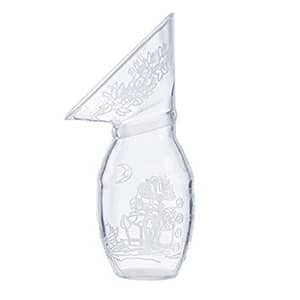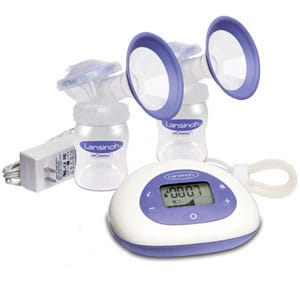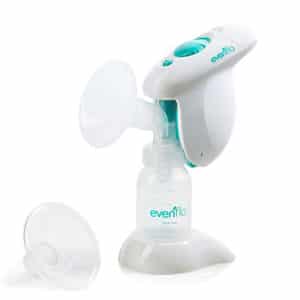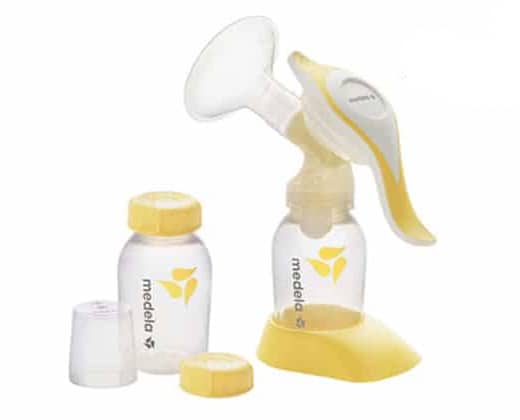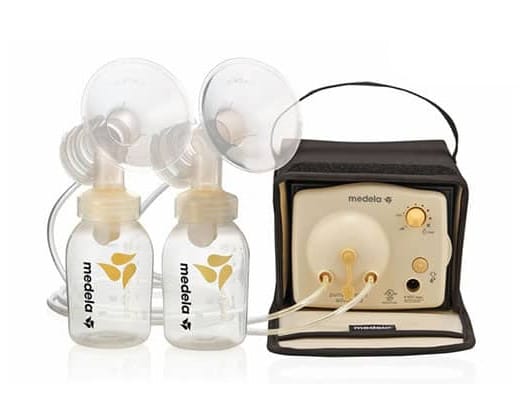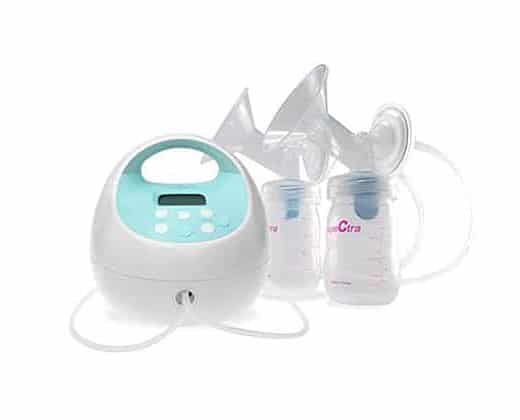
If you’d like to continue feeding your baby with breast milk even when you’re not around (being at work or running errands), having a quality breast pump is a must. But finding the right model isn’t exactly an easy thing to do – it’s hard to find the perfect fit, since what one mother finds comfortable might feel abrasive to another. But, have no worries – that’s why we’re here. Our team at My Traveling Baby knows a lot about these things, and we’re here to help you find the models that are reliable, quiet, and easy to use.
Our reviews and articles will help you get to know more about these versatile devices. We’ll try to show you all about the features, advantages, and flaws of the most popular models, as well as what are the characteristics you should look for when buying your first breast pump. Let’s do it!
CATEGORIES TO CHOSE FROM
MANUAL
With these types of breast pumps, moms have to use a lever or a handle to create the suction and thus express the milk from their breasts. The milk will, then, be collected in an attached container. As you might have already guessed, the manual breast pumps are also the least expensive ones.
ELECTRIC
An electric breast pump is, of course, the most powerful option. Many electric models allow double pumping – and this doesn’t only reduce the pumping time, but also stimulates the milk production. If you need as much breast milk as possible, an electric breast pump is certainly the best choice.
BATTERY OPERATED
As the name suggests, these types of breast pumps have batteries that make them highly portable and very convenient. They are an excellent choice if you’re a mom who plans to pump only on some occasions. There are even some “wearable” models that will allow you to discreetly wear them under your clothes.
PROS
- Small and lightweight
- The 2-Phase Expression
- Easy to assemble
- Easy to clean
CONS
- Not as quick as the electric models
- Exhausting to use
One of our favorite manual breast pumps is definitely the popular Medela Harmony, which is a slightly updated version of the outstanding 2004 model. The guys and girls at Medela certainly know how to do the job – when it comes to breast equipment; they have gone from a family owned company to a global market leader. The Medela Harmony is one of their latest models, and certainly one that deserves a more detailed look at its features. It is already one of the company’s bestsellers, and if you’d like to know the reason behind that – read on!
When it comes to assembly, nothing beats Medela Harmony. Getting this together is incredibly easy, as you only have to use the instructions (with helpful illustrations), and everything is done in minutes. The model is using the so-called 2-Phase Expression, which mimics the baby’s suckling rhythm and is one of the most innovative techniques in the world. This technology promotes simple but effective breast pumping experience and is certainly something that deserves special praise.
The manufacturer claims that this model isn’t intended for everyday use. If you need to use a pump frequently, the Medela Harmony isn’t for you – hand gets tired after only about 10 minutes of pumping. Of course, that is something we expected, as this is, after all, a manual breast pump. The Medela Harmony is also very easy to clean – after use, you only have to disassemble the parts and clean them.
This model offers a good value for the money, as it can express a lot of milk in a short space of time. It’s among the best manual pumps on the market right now.
Medela Pump in Style Advanced
PROS
- Value for money
- 2-phase expression technology
- Very efficient
- BPA-free
CONS
- Louder than some other models
- Moisture can build up in the tubing
It’s no wonder that we think that the Medela Pump in Style Advanced is among the best models of this type on the market. To put it simply, it’s just a great model. It is highly efficient, as it produces large amounts of milk in a short amount of time. It is also portable, with the pump part being built into the included tote bag and allowing you to just pick the thing up and head wherever you want. To top it off, it also comes with useful accessories and at a competitive price. Let’s see what it offers!
Like many other models on the market, the Medela Pump in Style Advanced also uses the two-phase expression technology. This means that the model starts with a quick and repetitive tug, followed by the full expression phase which allows longer and stronger suction. All of this mimics the baby nursing and is a feature that we’d like to see on all other models. Some models are better suited for the lighter pumping schedules, but if you’d like to give your baby more milk from the bottles than from the breast, this model will do the job with ease.
The Medela Pump in Style Advanced comes with several accessories like the ice packs and the cooler bag. They will help you keep the milk cool until storing, and are great accessories for the mothers who do the pumping during the lunch breaks at work. The model can run on AA batteries, or be plugged in.
Although not flawless, we can see why the Medela Pump in Style Advanced is so popular – it definitely deserves our recommendation.
Spectra Baby USA S1
PROS
- Hospital-grade efficiency
- Quiet while working
- Easy to transport
- BPA-free
CONS
- One size flange
- Limited instructions on cycle for the beginners
When it comes to electric breast pumps, we can safely say that the Spectra S1 has it all. It has an incredible functionality, coupled with easy portability and a great price, which definitely makes it a model worth considering for purchase. Unlike some other models, the Spectra Baby USA S1 is a hospital-grade pump, which means that it is highly reliable and won’t let you down. And seeing as it quickly became one of the most popular electric breast pumps on the market, we’ve decided to take a closer look and see what it has to offer.
The main selling point of this model is definitely its efficiency. With it, you can get lots of milk in a short amount of time, with the vacuum range going up to 350mmHg. And even though it is so strong, that doesn’t mean that it’s noisy – you can easily incorporate this pump as part of your everyday life, as its 45 DB of noise is quieter than your standard fan. The material that the S1 is made out of is, fortunately, BPA-free, and the whole thing is compact and lightweight enough for you to easily carry it around in your purse.
Other features worth noting are the 2-level built-in light, the ability to use both the AC power and the batteries, as well the ease of cleaning. We also liked the presence of the convenient handle, as well as the overall, attractive design of the whole model.
It’s easy to see why the Spectra Baby USA S1 is our favorite electric breast pump – it is not flawless, but it’s still ahead of the competition. Purchasing this model can’t really turn out as a mistake!
CHOOSING THE BEST BREAST PUMP – BUYER’S GUIDE
Buying your very first breast pump can be very hard, especially if you don’t know a lot about these things. But, have no worries – our buyer’s guide will help you decide which model is the right for you.
WHAT IS A BREAST PUMP?
A breast pump is a device that can extract the milk from the breasts, allowing mothers to store it and use a bottle to feed their babies with it whenever they want. The breast pumps are used to relieve engorgement, stimulate the milk supply, feed premature infants, and they’re also quite popular with moms who’d like to continue breastfeeding once they get back to work.
They can be manual, battery-operated, and electric. The manual pumps are intended for occasional use and are much cheaper, while the battery-operated and electric models are noisier, bulkier, and more expensive, but also far more efficient.
HOW OFTEN DO YOU PLAN TO USE IT?
- Only occasionally
A manual pump, which is operated by hand, isn’t really a good choice if you’d like to express frequently. The reason behind this is the fact that it’s operated by pulling or squeezing the handle and the repetitive movements can be truly tiring sometimes, and even cramp inducing. They also can’t really provide sufficient stimulation, and can’t empty the breasts as thoroughly as the electrical ones can.
But if you just want to use it to relieve the full breasts or take some milk out so that you can enjoy a night out, a manual breast pump will do the job. This type is also lightweight, which makes it highly portable.
- Frequently
If you’re a mom who likes to express a few times a day, feed hungry multiples, build a supply in the freezer, or have a premature baby, investing in the quality electric pump would be the wisest decision. It’s more efficient and faster. We recommend you to get a double pump if you’re a mother of multiples.
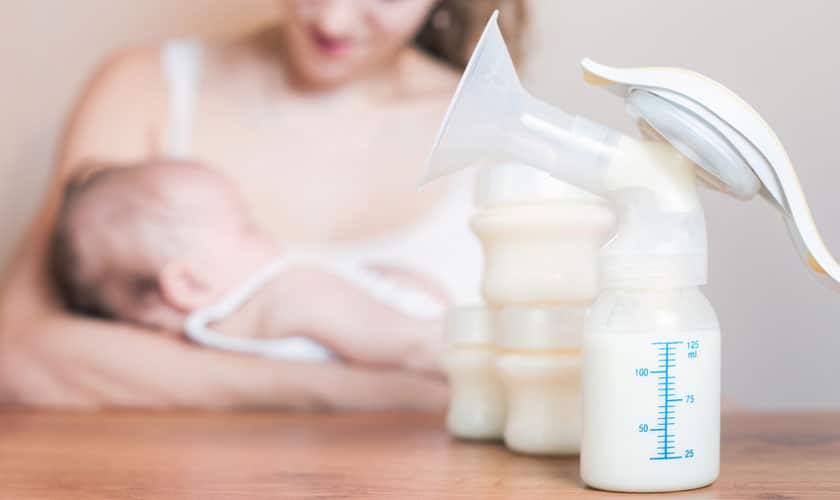
WHERE DO YOU PLAN TO USE IT?
If the discretion is among your top properties, you should definitely avoid the electric breast pumps. A manual model is a much better choice if you want to stay quiet while pumping. The electric models will also need a source of power (if they’re not battery-operated, of course) and aren’t as compact as their manual cousins.
But they’re also far more efficient, so if you’re expressing a lot throughout the day, it won’t take ages to get the milk with them, nor will they cause you to have hand cramps. Some models will even have adaptors for the car battery, which can be quite useful.
We should also mention that the manual models are far more reliable since they don’t have mechanical parts that easily break down.
WILL IT FIT THE BOTTLES YOU USE?
Most models will come with an included bottle, allowing you to express the milk directly into it and removing the need to transfer the fluid into another container. Many models won’t have the compatibility with other kinds of bottles, so we advise you to check everything out before you decide to make the purchase.
IS IT BPA-FREE?
Today, many companies are committed to provide moms with breast pumps and accessories that are BPA-free. The reason behind this is the fact that the breast pumps and bottles need to be sterilized, and the high temperature of sterilization produces some very harmful chemicals. A model that qualifies as
BPA-free is the one whose parts contain no BPA, especially those parts that come in contact with the baby’s lips or the milk.
HOW WILL YOU CLEAN IT?
Before each use, a breast pump will need to be sterilized. Generally, the manual models are much easier to clean than the electric ones. You will need to carefully read the manual for this, as every model comes with some specific instructions about the sterilization and cleaning. For example, not every model is dishwasher safe and not all parts of every model can be washed in the water of high temperature.
And when it comes to drying, don’t use cloths or towels – they might contain germs. Instead, leave the breast pump on a clean rack and let it dry out.
WHERE DO YOU START?
If you’re about to buy your very first breast pump, you will want purchase a model that perfectly suits your needs. If you don’t know where to start, we advise you to check out our reviews of the best breast pumps – they are straightforward, honest, and very informative.
FEATURES TO LOOK FOR
When buying a breast pump, there are certain features that could make the whole pumping process a lot easier and more convenient. Let’s have a look at the most important of them:
- Variable suction or speed
Some electric models come with variable speed or suction levels, which is designed to let moms control the overall speed of the milk expression. This will allow you to start off the whole process slowly, and then gradually increase the speed. Some models will also give you the option of the so-called phased expression, which is designed to simulate the baby’ sucking. This also stimulates the milk to flow faster.
- The breast shields
These would be the plastic parts of the pumps that are designed to cover your nipples. The materials that these shields are made out of vary – some are more flexible, and some rigid. Some shields are transparent, and some are opaque, which makes it hard to see the point at which the milk starts flowing.
It is of crucial importance to get a model whose breast shield will have the right fit – otherwise, an ill-fitting shield will have an adverse effect on the suction and feel very uncomfortable. It could even cause you pain.
Some companies will provide online guides that will tell you if your model’s shield fits correctly, and some models will allow you to buy alternative shields to be used instead of the original ones.
- The milk storage cups
Most models will come with some kind of a storage container – and these range from a small pot to a spare bottle. You can also buy these storage containers separately if you’re in need of spares or replacements.
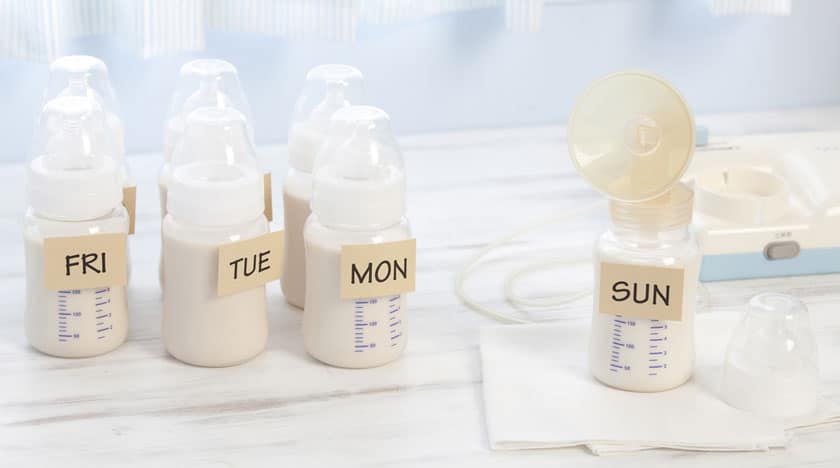
- Valve membrane
Every model has a valve, which is made up out of a few pieces of plastic and has a membrane. This little piece of plastic might seem unimportant, but we advise you not to lose it, as it is, actually, vital to the whole breast pump. The membrane and the valve are there to stop the expressed milk from going back to the pump mechanism. Some models will have this valve already assembled, and some will require you to fit both parts into the pump before you start pumping. Sometimes, this can be hard to do, as both pieces are really small.
Although most breast pumps come with a spare valve membrane, it’s quite easy to lose it or misplace it. Make sure to always know where this part is.
- The dishwasher-safe feature
Some models are dishwasher-safe, and this makes the cleaning process a lot easier. But still, don’t forget to check out if there are any pools of water left once you’re finished with washing. And even though you’ve just cleaned it, you will still need to sterilize your breast pump before you use it. Don’t forget to check out the manual for the information on disinfecting and cleaning your model in a correct way.
- The power source
The biggest amount of flexibility comes with models that run from both the power cord and the rechargeable or disposable batteries. Also, you could buy a car adapter if you’re traveling a lot and want to do some pumping on the go.

- The adjustments
Both the cycle rate and the suction level of your new model should be adjustable. This will give you the control of the rate and intensity at which the pump will suck and release, making things much more comfortable.
- The case
Most of the double-breast models will come with their own cases, for both the pump and its accessories. But if you’d like something a bit more discrete or durable, you will have to invest into an additional case.
- The cooler/ice packs
Milk needs to be kept cold once pumped, and that’s what the ice packs are there for. Even if you have a mini-fridge at work, you will still want some sort of a cooling system to carry your milk home.
FREQUENTLY ASKED QUESTIONS ABOUT BREAST PUMPS
Q: How often do I need to do the pumping?
A: In the beginning, pump every two or three hours for at least 15 minutes. A newborn needs to eat 8 to 12 times a day, and we would advise you to mimic that schedule as much as it is possible.
Q: When can I start to drop the pumps?
A: Most women start dropping the pumping sessions once they establish the supply, and how many pumps can one drop is totally individual. Some ladies manage with just 3 or 4 a day, while others do it eight times a day to keep the supply up. Most people should be able to do 5 or 6 pumping sessions for one day without having a dip in their supply.
Q: When will I establish a supply?
A: Most ladies establish their supply after 12 weeks. This will happen when the milk production moves away from being driven by hormones to being driven by supply and demand. In order to find out if you’ve managed to establish a supply, you will have to keep track of your production on a daily basis. Make sure to notice if it stays consistent or if it fluctuates. Some women make spreadsheets to make it easier, tracking the time of each pumping session and the overall output of each breast. There are also several smartphone apps for this.
Q: What does it mean to have an established supply?
A: This is one of the most frequently asked questions when it comes to breast pumping, and it definitely deserves a proper answer.
When you’re emptying the breasts regularly, they will start to make more milk. The milk production will slow down once the breasts are full, and speed up once they’re empty. Hence, the more often you’re using your breast pump, the faster your body will replenish the supply.
If you, for example, pump seven times a day, your body will respond by filling the reservoirs and allow your kid to eat frequently. If you do it only three times, your body will know that the child eats only thrice a day and will replenish enough milk for that eating schedule.
In this way, the supply of milk will be established by you telling your own body how much food your kid is eating. If you empty the breast more often, you can easily increase the supply. If you pump less frequently, you will also decrease the supply.
Q: How much should my infant eat?
A: This depends on your baby. An average infant eats 30oz a day, beginning around nine weeks of age until he or she turns six months. Some babies will eat less, and some will eat more.
Q: How long is my freshly pumped milk eatable?
A: This depends on the place of storage:
- In the fridge – up to one week
- In the deep freezer – six to twelve months
- At the room temperature – four to six hours
Once defrosted, the milk has to be used within the following 24 hours.
Q: What kind of a pump should I get?
A: This depends on how frequently you are planning to do the pumping. If you’re planning to do it only occasionally, you should go for an inexpensive manual pump. If you’re, on the other hand, planning to do a lot of pumping, go for an efficient electric model, or a battery-operated one.
Q: The pumps are expensive. Do I really have to buy one?
A: Yes. A pump of the low quality will provide you with a low-quality output – a high-quality model is simply a necessity.
CONCLUSION
In conclusion, we can safely say that the breast pumps are one of the most convenient and versatile baby-related products on the market. You probably already know that the breastfeeding is the healthiest choice for both the babies and the mothers. When you’re doing it, you’re giving your baby the most natural gift that you can give to her, and you’re also reducing your own chances of getting various diseases. And even though the direct breastfeeding can create a loving bond between the baby and his or her mother, not all mothers can do it all the time.
And that’s what the breasts pumps are there for! These things can come in very handy when you’re away from your infant, allowing you to stimulate the lactation or relieve the engorgement in a relaxing way. But, with so many different models on the market, selecting the breast pump that will suit your needs can be quite hard. That is why we decided to get together and write down some reviews and articles – we’re experts when it comes to baby-related products, and are always ready to help the mothers in need. Read our reviews and find the right breast pump for you and your beloved baby!

